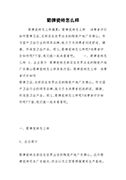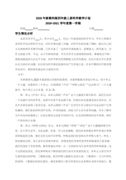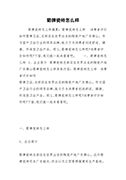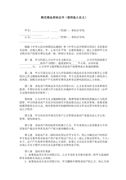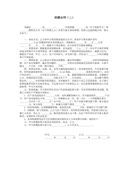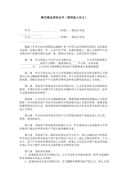1.3 第三教时(通用17篇)高一数学教案
1.3 第三教时(通用17篇)
1.3 第三教时 篇1
例1.如图(1) u是全集,a,b是u的两个子集,图中有四个用数字标出的区域,试填下表: 区域号 相应的集合 1cua∩cub2 a∩cub3 a∩b4cua∩b集合 相应的区域号 a 2,3b 3,4u 1,2,3,4a∩b 3 a 23b 411u8 c6 7b 4532 a1 u
图(1) 图(2)例2.如图(2) u是全集,a,b,c是u的三个子集,图中有8个用数字标出的区域,试填下表:(见右半版)区域号相应的集合 1cua∩cub∩cuc2a∩cub∩cuc3a∩b∩cuc4cua∩b∩cuc5a∩cub∩c6a∩b∩c 7cua∩b∩c8cua∩cub∩c集合相应的区域号 a2,3,5,6b3,4,6,7c5,6,7,8∪1,2,3,4,5,6,7,8a∪b2,3,4,5,6,7a∪c 2,3,5,6,7,8b∪c 3,4,5,6,7,8例3.已知:a={(x,y)|y=x2+1,xîr} b={(x,y)| y=x+1,xîr }求a∩b。例4. 设集合 .
例5. 已知集合 (1)判断b,c,d间的关系; (2)求a∩b.
例6. 已知集合
若 .作业: 《精析精练》p15 智能达标训练
1.3 第三教时 篇2
教材: 子集目的: 让学生初步了解子集的概念及其表示法,同时了解等集与真子集的有关概念.过程: 一 提出问题:现在开始研究集合与集合之间的关系.存在着两种关系:“包含”与“相等”两种关系. 二 “包含”关系—子集1. 实例: a={1,2,3} b={1,2,3,4,5} 引导观察. 结论: 对于两个集合a和b,如果集合a的任何一个元素都是集合b的元素,则说:集合a包含于集合b,或集合b包含集合a,记作aíb (或bêa)也说: 集合a是集合b的子集.2. 反之: 集合a不包含于集合b,或集合b不包含集合a,记作aëb (或bëa) 注意: í也可写成ì;ê也可写成é;í 也可写成ì;ê也可写成é。3. 规定: 空集是任何集合的子集 . φía 三 “相等”关系1. 实例:设 a={x|x2-1=0} b={-1,1} “元素相同”结论:对于两个集合a与b,如果集合a的任何一个元素都是集合b的元素,同时,集合b的任何一个元素都是集合a的元素,我们就说集合a等于集合b, 即: a=b2. ① 任何一个集合是它本身的子集。 aíaì¹② 真子集:如果aíb ,且a¹ b那就说集合a是集合b的真子集,记作a b③ 空集是任何非空集合的真子集。④ 如果 aíb, bíc ,那么 aíc 证明:设x是a的任一元素,则 xîa aíb, xîb 又 bíc xîc 从而 aíc 同样;如果 aíb, bíc ,那么 aíc⑤ 如果aíb 同时 bía 那么a=b 四 例题: p8 例一,例二 (略) 练习 p9 补充例题 《课课练》 课时2 p3五 小结:子集、真子集的概念,等集的概念及其符号 几个性质: aíaaíb, bíc þaícaíb bíaþ a=b 作业:p10 习题1.2 1,2,3 《课课练》课时中选择
1.3 第三教时 篇3
一、复习:子集、补集与全集的概念,符号二、讨论:1.补集必定是全集的子集,是否必是真子集?什么时候是真子集?2.aíb 如果把b看成全集,则cba是b的真子集吗?什么时候(什么条件下)cba是b的真子集? 3. 研究 三、例题例一 设集合 cua={5},求实数a的值.
例二 设集合 例三 已知集合 且a中至多只有一个奇数,写出所有满足条件的集合.例四 设全集u={2,3, },a={b,2}, ={b,2},求实数a和b的值.(a=2、-4,b=3)一、 作业 《精析精练》p9 智能达标训练
1.3 第三教时 篇4
一、 教学目标:1.能听得懂、会说、会读和会写句型i want to … do you want to …2.了解字母组合ar在单词中的发音。3.能诵读歌谣a clock二、 教学重难点:能听得懂、会说、会读和会写句型i want to … do you want to …三、 教学准备:ppt, things cards, exercise paper四、 教学过程:step1 warming up1. free talk:t: what day is it today?/how many lessons do you have today on…?/what subject do you like?2. show teacher’s timetable[ppt]t: this is my timetable. which day is a busy day for me?/what day am i busy? answer questions. find the busy day from the timetable.step2 presentation1. t: friday is a busy day for me./i’m busy on friday.how about you?how about david?2. review the text [ppt](1)t: what’s the time?/ what time is it?(2)t: what does david do at…?/what is david doing at…?3. write by memory: 值日,在晚上,准备好做某事,真的很忙,带些面包,六点半4. check the answer [ppt]answer questions. look at the clock and say the time.say the things david does according to the text. read the textwrite by memory, then checkstep 3 practice1. part e [ppt](1)t: what time does david get up?what time do you get up?how about sam?(2)six questions about six pictures.t: what time does sam get up?how does sam go to school at eight?what time do classes begin?(板书begin的同义词start和 -ing形式)do sam and you have lunch at the same time?does sam come home at ten to six or ten past six?what does do at nine?(3) talk about sam’s timetable(4) ask a boy and a girl to talk about their own timetable. 2. part f (play cards)(1) t: we do different things at different time. there are many things on your cards. look at your card and think what time do you do it? write the time on the back of the card in english.(2) play a game:(教师画钟)t(拿一卡have lunch): what time does he/she have lunch? guess!(教师注意记住两三个学生的事情及时间,为d部分做准备) 3. part d(1)t: look, it’s …(点钟),what is he/she doing?(指着刚才游戏中做该事的同学)(2)直接问该生:what are you doing?(3)t: i want to …do you want to join me?(4)p56(5)play games with cards.教师拿一卡用卡上事情问某同学:i want to …do you want to join me?(6)[ppt]地震图 4. exercise and check [ppt] 5. part g(1)[ppt] t: look, liu tao and his friends. let’s play a riddle.t: where are they? ( [ppt] show car)where are they going? ( [ppt] show park )do you know the name of the park? it’s a kind of shape. ( [ppt] show star)why are they going to the star park?(2)[ppt] show 4 words and the phonetic symble(3)read, find other words(记录学生所说单词,最后与quarter区别) 6. part h(1)[ppt] t: they’re having a good time, but “tick, tock, tick, tock”, time goes fast.(2)[ppt]t: look at the clock. what’s the time?is it late or early?they should go home before dinner students read part e by themselves. answer the questions talk about sam’s timetable [ppt]talk about their own timetableeg: i get up at…i go to school at … write the time in english. s: …has lunch at…ss read the correct answer together. s: he/she is … s: i’m … s: no, i’m … talk about these pictures. 学生看着自己卡上写的事说:no, i’m … do exercise and check the answer. try to find 4 words try to find other words which “ar” pronounced /a:/ ss: it’s ten to eight. ss: it’s very late.ss: read: before dinnerstep 4 consolidation[ppt] finish a passage about time step 5 homework[ppt] blackboard showunit 7 a busy dayi want to… 简笔画: 钟面do you want to join me?yes, …/ no, i’m…的单词 设计意图:step1从ppt表格中可以很直观地看到周五最忙,起到承上启下的作用。 step2以ppt“钟面+david做的事”的简单形式复现课文并复习,既复习了时间的表达,又在事件描述中复习强化了句型,同时又给到了学生关于课文的清晰线索,再穿插重点词汇的默写,多方位地帮助学生复习了a、b、c版块内容。 step3 e部分以sam在几点钟做什么事为线索复习单数第三人称陈述句的表达,提问设计富有新意,即以各图片为基点,设计包括一般疑问句、特殊疑问句、选择疑问句等在内的各类句型,并涉及单、复数及好几个不同疑问词,多方位地帮助学生开拓思维、巩固知识点,水到渠成地完成新授。最后学生通过谈论自己的时刻安排,又很自然地帮助学生从书本过渡到了实践运用。 f部分及d部分都有效地运用了卡片帮助教师达到教学目标。卡片上是各种事情,如play football,do homework等,学生为其配上时间成为完整句子,如:i do homework at seven. 教师再通过提问转而成为第三人称的练习,在转到d部分,顺理成章地完成新句型的新授与操练。 g部分是音标,多数教师会选择读一下一带而过,但这里巧妙地运用ppt,将学生带入了一个猜谜的情景,在快乐的活动中掌握发音与规则,极具新意。
1.3 第三教时 篇5
unit 6 doing housework section ⅲ常州市浦前中心小学 邱优芬 一、教学内容:《九年义务教育六年制教科书·牛津小学英语》5a第六单元第三教时(ask and answer&look and say)二、教学目标: 1、能正确地听、说、读、写词汇wash, clothes, sleep,jump2、进一步掌握句型what are you doing? i’m / we’re……3、进一步掌握句型what are they doing? they’re……4、熟练运用现在进行时态进行日常交际。三、教学重点及难点:能正确地运用现在进行时态进行日常交际。四、教学难点:单词clothes的发音五、教学准备:教学挂图及习题纸六、教学过程:(通过师生交流,创设英语学习的氛围)step1:free talk:a.t:hello, how are you? s:fine, thank you. t:are you free now? s:no, i’m not.t:what are you doing?
s:i’m having an english lesson. t:how about your mother?what is she doing? s:she’s doing housework.b.t:who’s your friend? s:he’s . t:what is he doing?s:he’s listening.c.t:hello, do you like swimming? s1:yes, i do. t:let’s swim. t:(指着s1)what is she doing? s:she’s swimming.step2.read the book(请2组学生分角色朗读)step3. say a chant(通过chant,使学生能熟练地表达动名词) t:singing, singing. what are you doing? s: singing, singing. we are singing.(边说边做动作)(依次说dancing , listening, skiing,standing, reading, watching,sweeping,drawing,swimming)(由chant引出 jumping, 新授jump)step 4.play a game(老师悄声命令s1做动作,然后让学生猜一猜,激发学生学习的兴趣。)t:(悄声告诉s1)draw a picture.s1(学生做动作)t: what is she / he doing guess?s:guess, she’s /he’s drawing a picture.t:what are you doing?s1:i’m drawing a picturre.t:yes, you’re right / no,you’re wrong.分别让学生read the book, sweep the floor, clean the desk……step5.通过play a game (让学生wash clothes)自然引入新授wash clothes(注意 clothes 的发音)step6. ask and answer(利用多媒体出示c部分的图片)1.通过师生对话,示范图1。t:what are you doing?s:i’m reading the book.2.看图2 学生合作work in pairs.3.利用图3中的两个人物,师生对话,然后再加入两个人物,创设复数情景。t:what are you doing?
s:we’re drawing picture.step7. look and say1.通过师生对话,示范图1t:where’s liu tao?s:he’s in the play ground.t:what is he doing?s:he’s sleeping.新授sleep2.同桌合作讨论图3、图4 work in pairs编小对话。step8.do exercise and check.(运用c部分图4, d部分图2)培养学生写的能力。(1)a:hello, is ben? b:yes, is ben. a:are you free now? b:no. a:what are you ? b: are the toys. a:see you.(2)a:hi, is nancy? b:yes. a: david? b:he’s the . a:what doing? b:he the book. a:let’s go and find.step9. homework. 1、完成c、d两部分。 2、创设情景用what are you doing? 和what is she/he doing?自编对话。 教后记:针对五年级教材知识面广,信息量大,词汇多的特征,我校英语教研组在本学期特意安排了三节五年级的研讨课,并邀请了区教研室马老师、张老师前来指导。在实际备课和授课的过程中,三位老师通过讨论,合理地组织教材,把a部分的内容分两教时学习,把b部分的单词分解到每一教时中,使学生在真实的语言情境中不知不觉地学会新单词;对于现在进行时态的初次出现,我们从学生实际能力出发,本着接触(sectionⅰ)—练习(section ⅱ)—较为熟练(sectionⅲ)—灵活运用(sectionⅳ)的原则,引导学生循序渐进地掌握,并运用chant来巩固现在分词,如: singing, singsing, what are you doing? singing, singsing, we’re singsing。类似的教研活动是我们教研组活动的常规, 在活动过程中加强了教师间的相互交流、沟通合作,促进了青年教师的成长。
5a第六单元第三教时(ask and answer&look and say) 来自98e范文网。
1.3 第三教时 篇6
一、教学说明:
1. 经过一段时间的英语学习之后,班级中的学生学习能力的高低也大致表现出来, 教师课上可以适时分层教学方法,让各层次的学生都得到发展。
2. 本课是继续学习表述能力的动词,如:dance, jump, write, 学生可以用一些简单的句式如:“i can … ”,来表述自己的能力。
3. 注意分层教学,要求一部分能力较好的同学,能用“can you …?” 来询问对方的能力,并进行回答。
二、教学内容
1)认知内容:
a. 单词dance, jump, write 达到“三会”要求。
b. 能用i can … 表述自己的能力。
c. 能流利地讲述page15 的故事。
2)能力要求:
能综合前面学过的知识,介绍自己的情况。
3)情感态度:
懂得自己这么多能力的取得是和老师辛勤教育分不开的,学会感谢老师,进而感谢身边一切关心我们的人。
三、教学步骤:
procedures
contents
methods
purpose
i.pre-task preparation:
warming up
1. sing the song by actions.
read>
2.students watch the scream and say the sentences one by one as fast as the cards change.
大多数学生已经会唱歌曲,这时可以让学生按自己的对歌的理解来设计自己的动作,表现歌曲。
利用制作的小课件,read, sing, draw 三个词的快速地在屏幕上交替出现,要求学生能快速说出能表述这张图的句子,最后定格在”dance”图片上,引出新单词。
ii.while-task procedure:
words teaching:
dance, jump, write
1. teacher says and act.
eg: i can dance.
can you dance?
students answer
s1: yes, i can dance.
s2: no.
2. encourage more able students to ask their classmates.
eg: s3: can you dance?
s4: yes, i can dance./ no.
3. students identify the three words by saying “i can …”
4. hold the word cards and ask them to read aloud.
( dance, jump, write)
5. listen to the tape and repeat on page14.
6.ask students to match the word cards and the pictures.
注意分层教学,让一部分能力教高的学生进行提问,使每个层次的学生都有所发发展,并能使课堂中语言交流更活跃。
a story
1. encourage students to talk about their ability and tick on the paper.
eg: i can read. i can dance.
2. a guessing game
students ask s1 to find out his/her ability by the least questions.
3. thanks for teacher!
thanks for the others around you!
学生将自己的能力边说边在表格里打勾,为下面的游戏做好准备。
要求每组一位学生上前,他所在组的同学用can you ….?来问出他的所有能力,看那组最默契,用最少的问题问完上台的这位学生的能力情况。
让学生学会说感谢,感谢老师的教育,感谢身边的人的关心。
iii.post-task activity:
1. listen to the tape and repeat on page15.
2. do the listening exercises on workbook page 10,12.
3. encourage students to introduce himself/ herself.
eg: i’m ____.
i’m ____ years old.
i can read.
…
注意thank的发音。
做听力练习可以让学生通过多种感官来巩固新知识,并调整课堂的节奏。
学生的能力是在新旧知识的整合中提高、发展的。
v. assignment:
listening,speaking and reading.
1. listen to the tape on page 14,15
2. read the new words.
3.tell your ability to your family.
let’s learn部分的单词,要让学生在不断地认读中巩固.
让学生和家长共同体验到学生学习英语的快乐和英语会话能力的提高。
四、教学提示:
1.媒体准备:
小课件,单词卡片,图片,录音机。
2.教学关注点:
1) 关注学生新知识和旧知识的融合。
2) 关注学生语音、语调。如:thank 的发音。
3) 关注学生能流畅地表达,注意在课堂中训练。
4)关注单词的音、形、图(意)的配对,这些也是学生常会混淆的。
3.资料分享:
a. 课件
b. 表格
sing
read
draw
dance
jump
write
说明:最后一格留给学生写书上所列单词之外的能力。
4.设计思路:
1) 从单词图片的交替出现引出新单词,让学生能比较愉快和自然到进入新的英语学习中。
2) 充分挖掘学生已有的能力,包括知识和潜能,在完成新任务的过程中提高综合能力。
5.教学反思:
教师应学习一些现代教学技术,使课堂更丰富。虽然也可以利用卡片和图片完成教学,但是变换一些固有的教学手段可以较大地提高学生学习英语的兴趣。让学生以更佳的情绪投入到课堂活动中来,进而得到更好的学习效果。
1.3 第三教时 篇7
教学过程 :
一、复习检查:
简述老孙头的形象。
二、研习新课。
1.这节课我们来研读一下,作者还着力刻画了谁?他的思想品质如何?
郭全海。
分马前,他抓住时机教育群众,“分了东西可不能忘本啊”,分马时,他虽然在最前分马,却“随随便便”牵一头;当老孙头马跑了,他立即“翻身骑上”自己的骡马去追,累得“人马都气喘吁吁”。当他发现老王太太不中意自己的马时,他就主动提出跟老王太太换马,并又召集积极分子开会,启发大家要从长远利益出发跟老王太太换马。当老王太太换走了老田太太的马,郭全海又做老田太太思想工作,决定“开春马驹归你”,使矛盾圆满解决。
从这些方面可以看出,郭全海是一个忠于党,大公无私,毫不利已专门利人的人。
2.小结中心思想:
本文通过对分马换马的描写,反映了翻身农民分得胜利果实的喜悦心情。表现了先进农民大公无私的精神以及广大农民在党的领导下,思想觉悟迅速提高。
3.体会本文写人叙事详略得当的特点。
元茂屯参加分马的有三百来户人家,作者只写了其中十来个人,这十来个人,也安排得有详有略,主次分明。说说看,哪些人写得详;哪些人写得略?
详写:郭全海(主),老孙头(次)
略写:赵大嫂子,白大嫂子,老田夫妇,老王太太等。
为什么要这样安排?
小结:这样能突出中心思想,有略写配合,使得文章内容完整、全面,写出翻身农民的欢乐和他们觉悟的提高。同时,在各种人物对比映衬中,更能突出主要人物的性格特征。
三,课堂练习:
三、四、六
作业
板书设计 :
1.3 第三教时 篇8
unit 2 in a toy shop (第三教时)
一 教学内容
look and say; look and read; sing a song
二 教学目标
1. 四会句型this is/ that’s your/his/her…, i think.及其回答yes, it is./ no, it isn’t.
2. 熟练句型what’s this/that?及其回答it’s a …
3. 能演唱歌曲we are happy bees.
三 教学重点和难点
1.四会句型this is/ that’s your/his/her…, i think.及其回答yes, it is./ no, it isn’t.
2.熟练句型what’s this/that?及其回答it’s a …
四 课前准备
录音机、磁带、学生自带玩具或图片
五 教学过程
教学环节
教师活动
学生活动
a
free talk
good morning.
how are you today?
what’s ten plus eight?
may i have a notebook?
this rubber is for you.
good morning.
not bad, thank you.
it’s eighteen.
sure. here you are.
thank you.
b
review
1. 复习课文,让学生用图片或自带的玩具来表演对话
2. t: what’s this ?
t: how lovely!
3. t: what’s that?
t:i see.
t: yes. the lion is nice ,too.
4. t: this is your dog, i think.
t: that’s his cat, i think.
5. t: i’d like this monkey.
t: thank you.
6. t:i like my bear.
分组表演对话。
it’s a panda.
it’s a rabbit.
that’s a nice monkey.
yes, it is.
no, it isn’t.
here you are.
i like your bear,too.
c
look and say
1. 教师与两位同学配合进行练习。
t: this is my book.
(拿着学生甲的书对他说)this is your book.(对着学生甲指着男女同学的书说)that’s his book. that’s her book.
反复演示后让学生练习。提醒学生this ,that的区别。
2. play a game:快速取物。
将学生的物品放在讲台上,各组派一名代表上来取出自己感兴趣的物品,边拿边说this is my/his/her…其余学生核对,符合实际的用yes, it is. that’s your/his/her…不符合的用no, it isn’t. that’s my/his/her…的句型表示物品所有者。
3. 用书上的图画进行句型的练习。
t: this is your lion ,i think.
让学生四人小组进行练习。
指名出来练习。很多学生基本已经能说出对话,但是在写的时候仍然会把一些简单的单词拼错,所以在以后的课堂教学中,要及时安排一些基础练习,巩固所学知识。两位同学与教师配合练习this is/that’s my
/your/his/her…
四人小组练习。
各组派代表上来玩游戏。
s1:yes,it is.
四人小组练习。
s1:that’s your lion, i think.
s2:no,it isn’t.
s1:this is his rabbit, i think.
s2:yes,it is.
s1:that’s her tiger, i think.
s2:no,it isn’t.
d
look and read
1. 让学生观察图画,自由地朗读短文,体会图意。
2. 指导学生朗读。
3. 请学生读。
4. 分角色读。
自由朗读短文。
跟老师读。
个别读。
分角色读。
e
sing a song
1. 放录音,让学生欣赏歌曲we are happy bees.
2. 领读歌词。
3. 放录音,让学生跟录音轻轻哼唱。
欣赏歌曲。
跟读歌词。
轻轻哼唱。
六 板书设计
unit 2 in a toy shop
this is your/his/her…, i think.
that’s your/his/her…, i think.
yes, it is.
no, it isn’t.
七 作业设计
1. 将d部分的内容写在练习本上。
2. 学唱歌曲we are happy bees.
八 课后反思
his 和her的区别,对学生来说是一大难点。正如之前的he和she一样,很多同学他她不分。今后对这个要加强练习。d部分主要练习了this is/ that is…i think.这一句型。在3b的时候已经接触过这一句型,所以学生操练起来也比较熟练。
1.3 第三教时 篇9
一、教学内容
《义务教育课程标准实验教科书 牛津小学英语》6a第四单元第三教时(look, read and write)。
二、教学目标:
掌握第一、二、三单元单词,句型,日常交际用语。
三、教学重点
熟练运用日常交际用语,句型进行交谈。
四、教学难点
把所学单词、句型运用于生活实际。
五、课前准备
(1)教具准备
多媒体, 一本台历,自制的公共图标,图片
(2)板书准备:预先写好课题unit 4 review and check
六、教学过程:
a free talk (5’)
what’s the weather like today?
what day is it today?
what’s the date today?
what season is it now?
which festival is in this season?
when is it(the festival)?
look at the picture. can you guess what festival it is?
教师出示一本有关公共图标的书。老师和学生一起开始谈论公共图标。
look, what’s on the table?
yes, it is a book. let’s take a look at the book.
what is this book about?
b practice
1、老师出示一些日常生活中常见的公共图标,学生了解这些图标的意思并造句。(8’)
如: crossing, exit, no left turn, no swimming, no littering ,speed limit
no swimming it means you can’t swim in the pool.
you shouldn’t swim here. it is dangerous.
2、学生根据所学知识出示所见公共图标自编对话。(8’)
pairwork:
s1: what does this sign mean?
s2: it means you couldn’t smoke, eat or drink.
s1: where can you see it?
s2: i can see it in the library.
3、老师请学生独立完成第四单元part c 部分的练习。请学生小组对话。(6’)
4、由第四幅图片谈论到日期和生日进行展开。老师给学生看一本台历。看看学生的反应,老师翻到哪一页请学生及时说出日期。(4’)
c、production (8’)
t: when’s your birthday?
s2: it’s on …
t: what do you like as a birthday present?
s2: i’d like…
t: when are your parents’ birthday?
s2: my father’s birthday is on…and my mother’s is on…
t: what would your father/mother like as a birthday present?
s2: he/she would like …
两个学生或三人一组,模仿上面的对话谈论自己或周边人的生日,如有人生日将近,由此可以自己扩展到去超市买礼物。
d、homework (2’)
make up a short dialogue by using the structures we’ve leant.
unit 4 review and check(第三教时) 来自98e范文网。
1.3 第三教时 篇10
教学说明:
1. 通过前两课时的学习,学生已经了解了有关人体部位的一些单词,并会进行简单的介绍。
2. 本课在学习有关指令的同时可以进一步巩固辨别已学单词。
一、教学内容:
1. 认知内容:
a.能听懂指令‘touch your toes. touch your arms. wave your hand. ’并能做出反应。
b.学会用祈使句‘touch your. wave your. ’结合相关内容发出指令。
2. 能力要求:
根据指令做出反应,并试着学会发指令。
3. 情感态度:
在听命令做动作的游戏竞赛中体验学习的乐趣。
二、教学步骤:
procedures
contents
methods
purpose
pre-task preparation
play a match.
‘ who is the quickest to respond?’
听令快速反应,复习旧知的同时顺理成章的引出下文。
while-task procedure
1.
‘touch your .’
1) t: (say the commands and do the actions to elicit the new sentence.)
have the class listen and follow the teacher.
2) teach a rhyme about body parts:
‘ touch your eyes,
and touch you toes.
touch your ears,
and touch your nose.’
边做动作,边说儿歌,理解含义,熟练句式。
2.
‘ wave your .’
1)
compare the commands:
‘ raise your hand.
wave your hand.’
利用动作的演示区分两者的含义。
2) ask students to listen to the teacher’s commands and do the actions.
3) quick response.
听令快速反应,在实践中进一步区别raise 和wave 的不同含义。
3. ‘ who is the best little teacher?’
ask some more able students to order the commands. the others try to follow and act.
为学生创造锻炼的机会,充分发挥小老师的功能。
post-task activity
play a game.
‘simon says’
滚动知识,丰富语言库。
assignmentplay the game (simon says) with their friends or parents.
1a unit4 oxford english book 1a unit 4 第三教时 来自98e范文网。
1.3 第三教时 篇11
一、教学内容
《义务教育课程标准实验教科书 牛津小学英语》3a第三单元第三教时
b look and learn 和d 2 play a game
二、教学目标
1.能听懂、会说以下八个水果类单词apples, oranges, pears, bananas, peaches, mangoes, pineapples, watermelons。
2.能初步了解名词复数的读音。
三、教学重、难点
能听懂、会说以下八个水果类单词apples, oranges, pears, bananas, peaches, mangoes, pineapples, watermelons ;并能初步了解名词复数的读音。
四、课前准备
1.老师带一些水果的实物,头饰和做好的课件。
五、教学过程
step 1 free talk
t:i’m miss liu. nice to meet you. s1:…
can you introduce your classmate to me?(引导学生用this is…来介绍同学给老师认识。) you are an apple in my eyes.(遇到表现比较好的同学可以表扬一下,也正好引出水果的单词)(你是老师最喜欢的学生。)
step 2 presentation
1. do you know “apple”?
this is an apple.(老师拿出一个苹果展示)
an apple 老师领读,学生跟读,开火车读等形式操练。
this is an apple. this is an apple,too.(左右两只手分别拿着一只苹果)
they are apples.(引入单词复数)
apples(强调复数结尾∕ζ∕的发音)(学生以不同的形式读单词)
apples,apples, i like apples.
2.what colour is my apple? yellow.
and i think banana is yellow,too. yes?
banana,( 出示实物) a banana(学生读,操练新单词)
bananas(引出复数)操练
3.用颜色大多为黄色的水果再教授 pears, mangoes,pineapples等单词。( 单词操练)
4.游戏学单词oranges, peaches。(单词操练)
game:what’s in my bag?
5.猜谜语学单词。it is a kind of fruit.
look at it.it is green.
eat it. it is red or yellow.
and “啊,吐” it is black.
guess,what is it? watermelon.
(把水果头饰分别带在几位学生的头上)
step 3 practice
1.listen to a rhyme:they are all very good.
2.game: touch and guess; smell and guess.等游戏。
3.(利用学生手里的水果问)what can you see in his/her hand?
i can see…
step 4 d play a game
1.先出示单独的水果图片或是只有一种的水果图片,鼓励学生用i can see…来描述图片。(课件展示)
2.投影课文图片或用课件展示
(示范) t: what can you see in the picture?
i can see an apple.i can see some bananas…
3. pair work. what can you see?句型问答谈论图片内容。
step 5 consolidation
1.教师示范:(学生和老师都带有相应头饰)
t:hello, miss apple. i’m miss banana.
this is mr watermelon.and this is my brother,mr pear.(引导学生用nice to meet you .来回答。)
t: oh, i can see a peach on your desk…
2.group work.(仿照编一组对话。)
3.act it out.
4.exercise: listen and draw.
step 6 homework
听录音跟读,并要求录下自己读b部分的声音。
六、 板书设计
unit 3 this is my father
apples bananas
peaches mangoes
pears watermelons
oranges pineapples
i can see a…
i can see some…
七、 教学后记
1.3 第三教时 篇12
一、 教学说明:
1.学生在第一、二教时中已经能听、说、读下列单词slide, doll, bicycle, balloon, ball, swing,并能用what have you got? i have got… he/ she has got …句型进行操练。
2.这节课的句型是what has he/ she got? he/ she has got… 而老师在上节课的回家作业中已经布置了采访老师和父母的作业。为本节课的学习打下了埋伏。
3. 这节课教的绕口令中的2个难点在unit 2: show me your book. &unit 3: let’s enjoy的歌曲中:i can read a little book. i can draw a little tree. i can sing a little song. 中已经出现过了,为本节课的学习打下了埋伏。
二、 教学内容:
1) 认知内容:
a. 能听懂会说并会用句型:what has he /she got? he / she has got…
b. 能听懂会说绕口令:the boy shows the ball to the doll. the little boy shows the little ball to the little doll.
2) 能力要求:
在学习和生活中能询问对方:他人拥有什么,并回答,并能表达他人拥有什么。
3) 情感态度:
通过绕口令的学习,培养学生的语音语调及激发英语学习的兴趣。
三、 教学过程:
procedures
contents
methods
purpose
pre-task preparation
warmer
1. enjoy the song. p16
配以动作的歌曲,既让学生进入了英语学习的氛围,又埋下了铺垫。
2. quick response.
eg. show me your book. show four. etc.
t→s s→s
通过快速反应这个环节,能进一步激发学生英语学习的兴趣,同时既巩固了旧知,又为引出新知作铺垫
while-task procedure
tongue twister.
1. quick response:
show a ball to me. show the ball to the doll. to elicit the sentence: the boy shows the ball to the doll. the little boy shows the little ball to the little doll.
2. encourage the pupils to say the sentences.
the boy shows the ball to the doll. the little boy shows the little ball to the little doll.
3. listen and read after the tape.
4. say the tongue twister together while doing the actions..
从quick response用旧句型引出新句型,难度不大,学生很容易上口。
模仿正确的语音语调进行绕口令。
2. a new pattern:
what has he/she got? he/ she has got …
1. teacher shows the survey and asks the questions.
e.g.: what has your father got?
p1: he has got …
to elicit the sentences: what has he/she got?
2. encourage the pupils to say the sentences.
what has he/she got? he/ she has got …
3. ask and answer in small groups.
e.g.: what has got?
he/ she has got …
让学生们之间通过询问和汇报的形式引出新句型。
让学生们之间通过询问和汇报的形式巩固新句型。
post-task activity
1. p40
1. listen and read after the tape. p40
2. look and say. p38 p40
3. read.
让学生通过听、模仿养成正确的语音语调。
guessing game.
4. teacher asks the students to play a guessing game what he/she has got.
e.g.: ------has he got…?
------yes, he has got… /no.
------what has he got?
------he has got…
学生用所学的语言知识来猜朋友的书包里的学习用品,不仅让其学以致用,而且激发了兴趣和好奇心。
assignment
read page 40 after the tape
play a guessing game with your parents.
四、教学提示:
1.媒体准备:布娃娃,气球,球,图片,录音机等
2.教学关注点:
1) 关注课堂中学生的小组活动,有针对性地进行个别辅导。
2) 关注绕口令时音近字的读音。同时注意学生在绕口令时的语音语调。
3) 学会调查报告后的一个口头汇报。
3.设计思路:
在while-task activity的环节,可以让学生通过口头汇报调查报告的形式操练,he has got… 然后通过你想了解某人拥有的形式,自由发问:“what has got? ”并请同学来回答。在post-task activity这个环节,采用让学生猜猜好朋友书包里有什么,来巩固句型:------has he got…? ------yes, he has got… /no. -------what has he got? he has got…,利用学生的好奇心里,激发学生英语学习的兴趣。
1.3 第三教时 篇13
一、教学目标:
1、使学生能听懂、会读、会说、会拼写:holiday early meet before。
2、使学生能听懂、会读、会说:national day, a farm, a film。
3、使学生能听懂、会读、会说本单元a部分内容。
4、能较熟练地运用句型:what did you do …? what else did you do?
二、教学重、难点:
1、重点:日常交际用语的掌握运用。
2、难点:过去式的正确表达。
三、教学具准备及辅助活动:
1、课件。 2、图片。
四、作业设计、安排:
1、课内:会读课文;会话练习;作课内调查。
2、课外:熟读课文;填空练习;调查及会话练习。
五、主要板书设计:
unit 5 on the farm
a: what did you do last national day holiday?
b: i watched a film.
i visited a farm.
a: what did you do on the farm?
b: on monday we watered trees and pulled up carrots.
on tuesday we milked cows.
a: what else did you do?
b: we collected eggs.
we picked oranges and tasted them.
六、教学过程:
step1: free talk
good morning.
how are you?
do you have any hobbies?
step2:review
what did you do on sunday?
what else did you do?
step3: new lesson
1、what did you do last national day holiday?
①出示词组:national day 及 last national day holiday(出现画面,帮 助理解)并朗读拼读有关单词
②引导学生思考:what did you do last national day holiday?
③出示句型并朗读:what did you do last national day holiday?
④师生问答(加上句型:what else did you do? 并出示句型)
⑤同桌练习(请学生接连问答)
2、课文上半部分 what did nancy/helen do last national day holiday?
①出示人物nancy。讲述:“nancy also had the national day holiday. what did nancy do last national day holiday?”
②学生齐问,播放回答:“i watched a film with my family on wednesday. it was a funny cartoon. we all like it very much.”。
③引导学生讲述所听内容并出示句型:“i watched a film.”。
④出示图片问:what did helen do last national day holiday? 播放回答:i visited a farm with my family on monday and tuesday.
⑤引导学生讲述所听内容出示句型:i visited a farm.
⑥同桌利用句型进行练习。(任选一答句nancy或helen的)
⑦、请部分学生表演。
3、课文下半部分 what did you do on the farm?
①讲述helen did a lot of things on the farm. guess: what did she do on the farm?
②讲述:listen! nancy is asking her for us now? let′s listen “what did she do on the farm?”.(声音画面同时出现)
③讨论helen 所做事情,借以判断学生猜想正确与否。
on monday? on tuesday? what else?
④出示相关句子并朗读
⑤同桌练习
⑥请部分学生表演
4、回到全文
①出示:10月8日,讲述:it is the first day of school after the national day holiday.
②听录音,课文叙述部分
③教授单词:early meet before
④讲述:let′s listen what they are talking about.
⑤播放对话录音
⑥出示课文内容,听录音、跟读。
⑦自由朗读。
⑧分角色朗读。
5、巩固练习
①do a survey
name what did you do last national day holiday? what else did you do?
②个别交流
step 4: consolidation
1、讲述本课所学内容
2、齐读
step 5: work
it was the _______ _______ _______ last week. nancy _______ a film with her parents. helen _______ a farm. on the farm, she _______trees, _______ _______ carrots, _______cows, _______ eggs, _______ a lot of _______ and _______ them. they were very happy!
1.3 第三教时 篇14
二 教学目标:
1 能熟练掌握本单元所学的单词。
2 能比较熟练地在情景中运用本单元所学的日常交际用语。
3 能唱歌曲colour song。
三 教学重点:
1 单词:a shirt,a blouse,a jacket,a sweater,a t-shirt,a dress,a skirt,a coat,new和nice。
2 日常交际用语:look at his/her… how nice! look , this is/that’s…
四 教学难点:
1 能熟练听说本单元所学的单词。
2 能在情景中灵活运用本单元所学的日常交际用语。
五 课前准备:
1 教具准备:录音机、磁带、图片。
2 教学准备:课前请每位学生带好彩笔。
3 板书准备:黑板上预先写好课题unit 7 it’s nice
六 教学过程:
step 1 everyday english
以good morning/afternoon,boys and girls. how are you?和学生打招呼,学生依照实际情形回答。
step 2 revision
1.复习look at…
教师指自己的衣服或图片,说look at my…全班学生表示赞叹: it’s pretty/nice/smart./ how nice!
教师示范几次后请一位学生指自己的衣服,说look at my…同桌学生表示赞叹。
2. 复习his/her
教师举起学生的物品说look at his/her…全班学生应答: it’s pretty/nice/smart./ how nice!
教师取出一大叠图片,一名学生上来任意抽出一张,半班学生说look at his/her… 另半班应答it’s pretty/nice/smart./ how nice!
3.复习look, this is/that’s…
出示一系列图片,分别放在近处及远处,从个别到集体操练look,this is/that’s…个别学生上来自己取图片操练句型。
step 3 presentation and practice
复习巩固表示颜色的生词。
例:t:(出示dress的图片)what’s this?
s: it’s a dress.
t: what colour is the dress?
s: it’s blue.
t: yes. this is a blue dress.
(出示skirt的图片)this is a white skirt.
ss:(看书上fun house第一部分,模仿t进行练习)
step 4 listen and number
ss:(听录音做,然后进行交流,核对)
the key: (a.6 b.7 c.4 d.2 e.1 f.8 g.3 h.5)
step 5 draw and guess
1. t在纸上画件衣服(以本单元所学服装为主),并涂上色。
2. 先让学生猜画的是什么,学生a coat?a shirt?…
3. 猜中后,再让学生猜是什么颜色what colour?
4. 数次示范后,让学生分组练习。可评出猜谜优胜者。
step 6 sing a song
1. 学生听录音,跟唱colour song。
2. 学生唱。
step 7 practice
do ex.b,c in wb。
step 8 homework
复习本单元所学内容。
七 板书设计:
1.3 第三教时 篇15
七彩蝴蝶 第三教时
一、 教学目标:
1、通过美术欣赏和美术表现,使学生感受美的存在。
2、提高学生对美的感受力和艺术表现能力,并能在审美活动中充分拓展他们的思维和想象力。
二、教学重点、难点:
1、通过感知蝴蝶的形态和多姿的花纹及色彩,练习对颜色的综合运用。
2、理解对称的形态,找出规律,展开不同的评价方式。
三、教学准备:
课件、彩纸、剪刀等
四、教学过程:
(一)、猜一猜:
课件:表现蝴蝶的生长变化的过程:(每出示一个过程就猜一猜)毛毛虫的蠕动—结茧—蜕变化蝶---飞舞在花丛中的蝴蝶。
(二)、看一看:
出示不同形态、花纹、色彩的蝴蝶图片或标本视频展示,学生讨论,对蝴蝶的特征进行分析,归纳蝴蝶的基本形态,蝴蝶的共同特征是什么? ----对称。并举出例子。
(三)、听一听:
倾听乐曲:《扑蝶》引导学生感受乐曲,表达自己的感受,为乐曲命名。
(四)、读一读:
“蝴蝶飞,我不追,蝴蝶落,我不要。”这是农村学生看见蝴蝶时哼唱的童谣。或者朗读“小蝴蝶,穿花衣,猫抓你,飞到西,飞到我的手心里,鸡吃你,说说话,飞到东,放了你。
(五)、赏一赏:
课件:你知道很多艺术家都喜欢以蝴蝶为题材进行创作,你能说出几钟吗?(剪纸、舞蹈、工艺品、手饰等)课件欣赏。
(六)、演一演:
欣赏一段蝴蝶飞舞的录象:蝴蝶飞舞时的动态是怎,怎样的?谁来模仿一下。
(七)、做一做:
我们可以采用什么样的表现手法来表现蝴蝶呢?
老师示范剪纸:1、将彩纸对折
2、用铅笔画出蝴蝶的半边轮廓
3、用剪刀剪下轮廓。
4、将蝴蝶贴在作业本上,再添画。
学生用剪纸的方式完成一只蝴蝶。学生制作,教师巡回指导。
五、课堂总结、下课。
教学反思:
有人说,孩子的模仿能力非常强。教师一示范,学生自然就会跟着模仿。所以有人提议,为了培养学生的创新思维、创造力。教师在课堂上最好不示范,鼓励学生大胆创新,就算要示范,也要一示范完就把范作收起来,避免学生临摹。教师示范,学生就会跟着模仿,这种情况确实存在。虽说模仿也是一种学习,但是一味的模仿,就会阻碍创新思维、创造能力的发展。还有人说,教师的示范、演示是对学生能力、智力的不信任。所以示不示范是一直困惑着我的一个大问题。在平时的课堂上,我一般的做法是绘画内容不示范,大的原则是以引导学生回忆、想象为主,偶而示范一下难点而已;手工制作就完整示范整个制作过程。我也不知这样处理是否妥当。但在实际的课堂教学中,我觉得应关注学生的实际情况,因材施教,具体问题具体分析。在今天《七彩蝴蝶》这一课中,我在二(1)班授课时重点示范了剪蝴蝶,并且让学生完整看完我的操作过程,结果留给学生制作时间太少,在课堂上学生无法完成今天的作业。下午在二班我就尝试不示范,让学生自主创作。也有学生自己开始动手制作起来的,也有画的。但是还有很多学生不会制作而又不满足于绘画,他们对于手工制作有更大的兴趣。这时不会制作的学生会很困惑、很苦恼,他们一般会手举工具材料围到讲台前,很焦急地央求示范一下:“老师,怎么做的,这是怎么做的呢?”“帮我做一下啊!”“老师,做一下给我们看吧!”而且学生的人数还不少,有些是真不懂,有些是来凑热闹的,更有一些本来已会做的,看到老师在示范,他们也要来看个究竟,生怕有更好的方法没学到。针对这个问题,在课后我又想到了另外一个方法,那就是我在教学生剪蝴蝶花纹时所采用的:鼓励会做的学生充当“小老师”,帮带不会做的学生。一开始教师就不示范,让生生之间互动起来,自主探讨方法方式,自由选择帮带对象。当然以上的方法可不可行,就有待于接下来的实验吧!希望我在以后的教学实验中探索出更多更适合学生发展的好方法。
1.3 第三教时 篇16
一、教学说明:
1.通过上节课的学习,学生对于中国饮食文化有了进一步的了解,知道中秋佳节是中国的传统节日,我们会吃mooncake, taro, bean等。
2.由于学生接受能力不同,部分学生对于what do you like to eat? i like to eat…掌握不是很好,可以在本课时中继续巩固。
3.本课是学习有关秋天的单词,如autumn, leaf; 并学习句型i/you have got a/an…,来表述自己所拥有的物品和食物。
二、教学内容
1)认知内容:
a.单词autumn, leaf达到“三会”要求。
b.能用i / you have got a / an…表述自己或对方所拥有的东西。
2)能力要求:
能表演改编后的语言活动,增强了学生的团结协作能力。
3)情感态度:
在改编表演对话的过程中,感受到英语学习的魅力。
三、教学步骤:
procedures
contents
methods
purpose
i.pre-task preparation:
1. warming up.
2.revision
1.chant.
2.listen and act.
1. show the picture of page 28.
2.ask and answer:
what do you like to eat?
i like to eat…
3. make a short dialogue then act it out.
做做热身,增强朗读的乐感。
通过让学生问答、表演对话,充分发挥学生运用知识的能力,培养口头表达能力。
ii.while-task procedure:
words teaching:leaf
1.teacher shows a leaf and ask: what is it?
2.elicit the word: leaf
3.read the word.
4.make small rhymes in groups.
5.say a rhyme as following:
one, two, three.
it’s a leaf.
four, five, six.
pick up the leaves.
让学生充分发挥想象自编儿歌,从而使思维得到拓展。
琅琅上口的儿歌,对于单词leaf的单复数都有了更深的印象。
words teaching:autumn
1. have the pupils enjoy four pictures, then ask:
e.g. what can you see?
what colour are the leaves?
2. teacher introduces one of the pictures:
e.g. look. the leaves are yellow. the leaves are following. autumn is coming.
3. ask the pupils to read the new word: autumn
4. ask and answer:
e.g. t: autumn, autumn, what can you eat?
pn: autumn, autumn, i eat a/ an…
师生问答一方面培养了学生的口表能力,一方面培养学生的观察能力,从图中获取一定的信息。
用一问一答式的形式操练单词,学生新奇,但很有效。
new patterns:
1.i have got a…
1. show the objects and say:
e.g. look! i have got a pencil. i have got a book. and i have got a ruler.
2. repeat the sentences.
3. make sentences with “ i have got a…”
4. have a match:
ask the pupils to say more and more sentences with “ i have got…”
让学生用新句型i have got…进行说话比赛,看谁说得又多又好。
2.you have got a…
1. have one pupil hide one object and play the guessing game:
e.g: t: you have got a…
p1: yes./ no.
2. read the sentence:
you have got a …
3. play the tape and say after it.
4. play the game in goups as the model.
e.g. p1: you have got a…
p2: yes. / no. i have got a…
猜的游戏,学生兴趣浓厚,课堂气氛非常活跃。
iii.post-task activity:
words for unit 6
1. match the words and pictures.
2. listen and guess.
训练学生听的能力,并通过获得的信息猜出相应的单词。
let’s play.
1. encourage the pupils to make the dialogue.
2. select pairs to act out their modified dialogues.
以小组的形式共同练习口语,并学会了运用所学来交际。
v. assignment:
listening and speaking
1.listen to the tape, say and act page 30
2.play the guessing game with your parents.
四、教学提示:
1.媒体准备:单词卡片、录音机、叶子、部分学习用品等
2.教学关注点:
1)关注整体认读卡片单词autumn和leaf。
2)关注单词autumn的发音;注意单词leaf的复数形式 leaves,可适当点拨一下。
3)句型i / you have got a…学生初次接触,可以通过猜物游戏反复加以操练,达到熟练程度。
3.设计思路:
单词leaf由实物引出,单复数通过诵读儿歌来加深印象;句型的操练通过不同的形式加以巩固,使学生始终处于兴奋状态。最后环节,学生用学过的其他物品进行猜物活动,让学生表演改变后的语言活动,旨在培养学生语言运用能力,展现自我风采。
1a unit 6 oxford english book1a unit 6 第三教时 来自98e范文网。
1.3 第三教时 篇17
unit 1 may i have…? (第三教时)
一 教学内容
work in pairs; read and act
二 教学目标
1. 能听懂、会说和会读日常交际用语good morning. here’s a… for you. happy teachers’ day!
2. 通过复习,能熟练掌握本单元所学单词和句型。
3. 进一步掌握句型this…is for…及其回答thank you./all right.
三 教学重点和难点
1. 通过复习,能熟练掌握本单元所学单词和句型。
2. 进一步掌握句型this…is for…及其回答thank you./all right.
四 课前准备
录音机、磁带、实物、单词卡片、贺卡
五 教学过程
教学环节
教师活动
学生活动
a
free talk
good morning, boys and girls.
how are you?
good morning, miss wang.
fine, thank you./not bad, thank you./not so good.
b
review
1. say a rhyme: a little book.
2. 复习单词和句子。
t: may i have a bookmark?
t: thank you. may i have a bookmark for su yang?
t: thank you.
用其它单词替换bookmark和人物进行练习。
让学生随着录音有节奏地朗读。
yes. this bookmark is for you.
sure. here you are.
学生练习对话。
c
work in pairs
1. t(手拿两本抄写本)this copybook is for you.引导学生甲边接本子边说thank you.然后把学生乙的本子给学生甲,说this copybook is for…,引导他说all right,并把本子给学生乙。
2. 让学生自己创设情景进行表演对话。
3. 完成书上练习。
s1:thank you.
s1:all right.
s1:this copy is for you.
s2:thank you.
学生自创情景进行对话表演。
让学生练习对话并会正确书写句子。
d
read and act
1. t在黑板上书写九月十日teachers’ day,让学生了解教师节的英语表达方式。
2. t:happy teachers’ day!教师节快乐!
3. t: here’s a book for you.
让学生说here’s…for…,了解与this…is for…意思是一样的。
4. 放录音。
5. 放录音,让学生跟读。
6. 指导朗读和表演。
7.用this card is for miss gao. all right.来扩充对话。
了解teachers’ day的写法。
学说happy teachers’ day!
thank you.
练习here’s …for…
听录音,观察图画。
跟读对话。
表演对话。师生表演,然后让学生表演。
扩充对话。
六 板书设计
unit 1 may i have…?
this …is for you. thank you.
this…is for… all right.
here’s a card for you.
happy teachers’ day!
七 作业设计
1. 默写本单元的单词。
2. 看图写对话。
3. 背诵并表演read and act。
unit 1 may i have…? (第三教时) 来自98e范文网。


